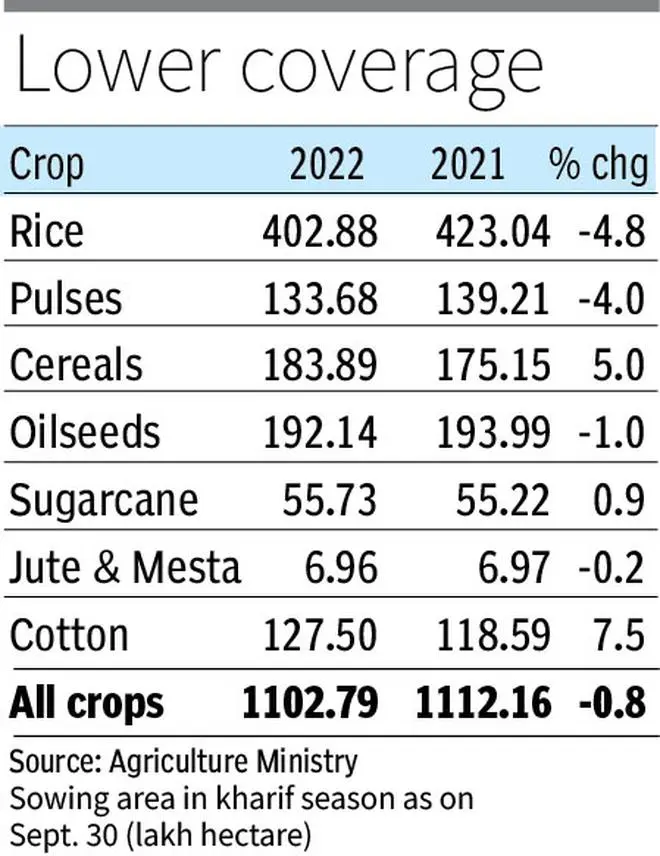Cotton, bajra and maize farmers have increased the area under the respective crops even as the kharif sowing season ended on Friday. The total acreage in the country has almost touched last year’s level, though the coverage of paddy, pulses and oilseeds is lower. The government has already lowered the production estimates of oilseeds and foodgrains including rice.
The total area under all kharif crops declined 0.8 per cent to 1,102.79 lakh hectares (lh) as of Friday against 1,112.16 lh a year ago, the Agriculture Ministry said in its weekly update. Arrivals of early-sown crops in mandis have begun from mid-September. But due to heavy rainfall in many parts, the harvest may be delayed a bit and farmers will have to wait until the crops dry. Harvesting is expected to be in full swing from October after Dussehra.
Higher arrivals
Pan-India mandi arrivals of moong, urad, soyabean and paddy (both basmati and non-basmati) were reported at about 6 lakh tonnes (lt) since September 15, which is 5 per cent higher than year-ago, according to agmarknet data.
As the final acreage data show that the area under paddy has dropped by 4.8 per cent to 402.88 lh till now from 423.04 lh in the corresponding period a year ago. The government had targeted the area at 414.73 lh. The non-basmati crop has been affected mainly in Jharkhand (9.22 lh fall), West Bengal (3.65 lh), Uttar Pradesh (2.48 lh), Madhya Pradesh (2.24 lh), Bihar (1.97 lh), Andhra Pradesh (1 lh), Assam (0.99 lh), Chhattisgarh (0.74 lh), Odisha (0.20 lh) and Punjab (0.12 lh). But the area has increased in Telangana by 0.97 lh and in Haryana by 0.94 lh.

“The productivity in Jharkhand is not high compared to other paddy growing States where the acreage is marginally down. So far, the crop conditions in most of the States are reported normal even though September had higher than average rainfall. The rice production may improve (from first estimate) if the yield goes up,” said an official in the Agriculture Ministry.
Production estimate
According to the first advance estimates released last week, rice production in the 2022 kharif season is likely to be 104.99 million tonnes (mt), down from 111.76 mt a year ago. The government had targetted an output of 112 mt.
The Agriculture Ministry data also showed pulses acreage lower by 4 per cent at 133.68 lh compared with 139.21 lh a year ago. Arhar, urad, moong, kulthi and other pulses coverage had declined.
Oilseeds acreage was down by 1 per cent at 192.14 lh as against 193.99 lh in the year-ago period, mainly due to 7.8 per cent lower planting of groundnut at 45.59 lh. Soyabean acreage recorded at 120.9 lh, same as last year.
On the other hand, the area under coarse and nutri cereals, including maize and bajra, ended higher at 183.89 lh against 175.15 lh in the year-ago period. But, jowar and ragi area is down by 3 per cent, each.
Cotton acreage has gone up 7.5 per cent at 127.50 lh against 118.59 lh, while that of jute/mesta dipped marginally at 6.96 lh from 6.97 lh. Sugarcane continues to be up at 55.73 lh from 55.22 lh in the year-ago period, the data show.




Comments
Comments have to be in English, and in full sentences. They cannot be abusive or personal. Please abide by our community guidelines for posting your comments.
We have migrated to a new commenting platform. If you are already a registered user of TheHindu Businessline and logged in, you may continue to engage with our articles. If you do not have an account please register and login to post comments. Users can access their older comments by logging into their accounts on Vuukle.